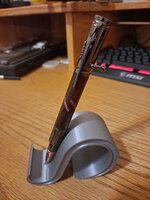Drewby108
Member
I like the bolt action mechanism, but I really wish there was more variety to the body styles that use it.
Pheasantwood with red, white, and blue veneer stripes. Leftover blank from a different pen I made for my girlfriend. This is the fourth blank used on this kit because the first two were crappy pieces of black palm and the third was a poorly assembled (didn't really expect it to work) segmented piece.
Pheasantwood with red, white, and blue veneer stripes. Leftover blank from a different pen I made for my girlfriend. This is the fourth blank used on this kit because the first two were crappy pieces of black palm and the third was a poorly assembled (didn't really expect it to work) segmented piece.

